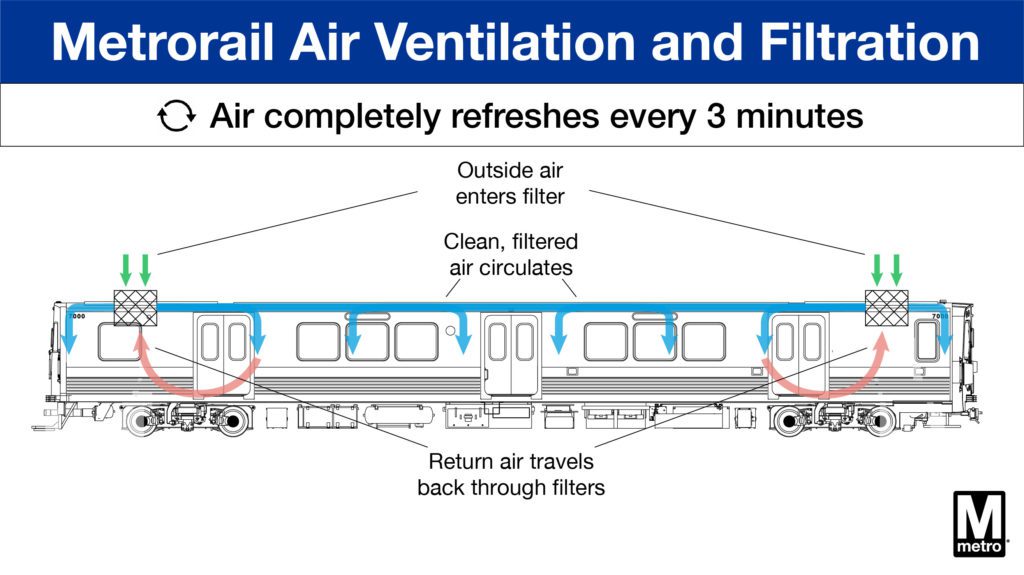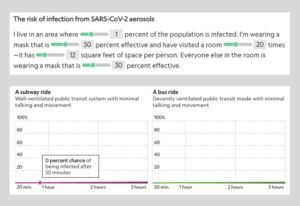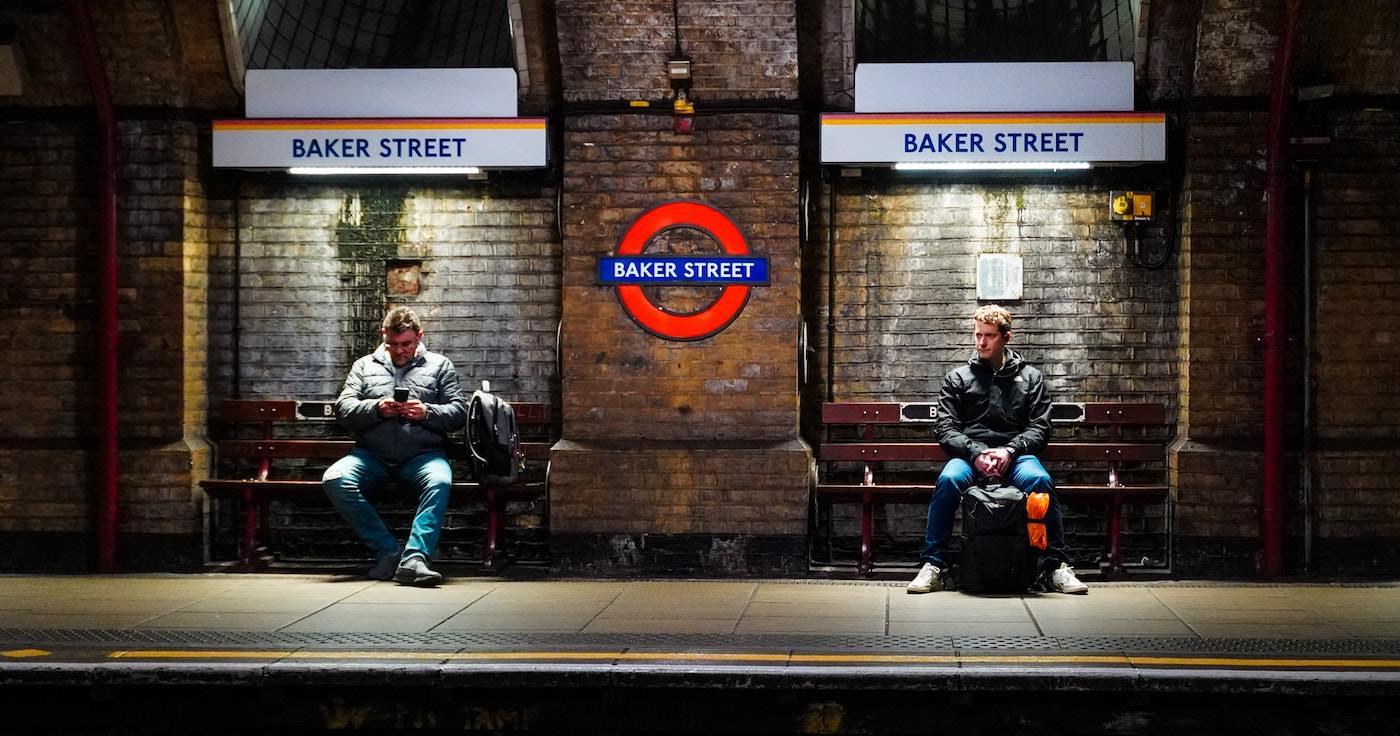Wells + Associates continues our compilation of the latest news relating to transit use and operation during the Covid-19 pandemic.
Update: June 29, 2021
Fresh Air Every Three Minutes on Washington, DC’s Metrorail
Fresh Air. From outside the train. Completely refreshed every three minutes. That’s what WMATA’s new video and TV ad assures riders about their new air filtration systems on their trains.
With face masks continuing to be required to ensure the safety of passengers and workers, WMATA stated:
As we follow the CDC’s direction on Covid-19, we have aligned our responsive cleaning and disinfection practices with updated guidance, which now indicates a deep cleaning is needed if a person known or suspected to have Covid-19 has been in an area in the past three days, down from seven days.
Across stations, trains, and buses, WMATA has taken the following steps:
- In stations and facilities, WMATA has upgraded to MERV-13 filters and are piloting the use of MERV-15 filtration levels.
- On Metrobuses, WMATA has upgraded to MERV-7 and are working with their vendor to move to MERV-10 as soon as possible, while also piloting the potential UVC sanitization systems.
- On Metrorail trains, WMATA has upgraded to MERV-9 and are piloting MERV-13 filters and UVC systems, thanks to funding provided by an FTA grant received earlier this year.

Other efforts WMATA has taken include:
- Requiring Face Coverings – “All riders and Metro employees must wear a face covering. If you need one, we have extras.”
- Deploying Hand Sanitizing Stations – “You’ll now find hand sanitizing stations throughout the system.”
- Continuing Deep Cleaning – “Using advanced hospital-grade cleaner, we’re scrubbing down our vehicles and trains every day.”
- Expanding Service – “Restoration of certain routes, expansion of late-night service and more frequent buses along selected routes gives riders greater flexibility.”
- Checking Before You Go – “Using their smartphones, riders can access crowdedness estimates of trains and buses from the WMATA website and participating apps.”
Update: October 21, 2020
New Research Indicates No Direct Link Between Subway and Covid-19 Spread
Gothamist reports on a new study that indicates that “the risks of taking the subway right now may have more to do with perception than reality.” The bottom line: masks and vehicle ventilation appear to be keeping the coronavirus at bay.
The study, commissioned by the American Public Transportation Association, determined that there is no direct correlation between public transit use and Covid-19 spread. The period from June 2020 to mid-August was studied. Increased infection rates were tied primarily to local community spread and communities with some of the highest spread rates have low transit usage.
NYU Study: Nearly a Quarter of Transit Workers Have Gotten Covid-19
In August, a pilot study that captured self-reports, not antibody tests, of transit workers showed that 24 percent of transit workers have gotten Covid-19. This compares with a New York State report in May that found that 14.2 percent of transit workers had Covid-19 antibodies, suggesting that workers may have continued to contract the virus into the late spring and summer.
The pilot study was conducted by researchers at NYU School of Global Public Health, in coordination with the Transport Workers Union (TWU) Local 100. Robyn Gershon, clinical professor of epidemiology at NYU School of Global Public Health, stated: “Through gaining a deeper understanding of how Covid-19 has impacted transit workers’ health and quality of life, we can determine how to best support them and protect them moving forward.”
CDC Recommendation: Wear a Mask on Public Transit
The Washington Post reported that the Centers for Disease Control and Prevention recommended that all passengers and workers wear masks on trains, buses and other public transportation to control the spread of Covid-19. While the agency has already recommended the use of masks generally, the new guidance is more strongly worded and possibly enables airlines and transit providers to press for more mask-wearing.
Update: August 17, 2020
Should you worry about your risk of exposure to COVID-19 while riding public transit?
As commuters begin returning to their offices and considering their commute options, many are expressing concerns about riding transit for fear of contracting the coronavirus. If you find yourself second guessing transit as a commute option, you may benefit from using this model on National Geographic’s website to determine your risk of infection.
You may be surprised by how low the risk can be relative to most other activities in enclosed areas. The model is consistent with what cities across the globe are finding with transit.

Why is transit a relatively safe option?
Major public transit subway systems in Japan, New York City, Philadelphia, Paris, and Washington, DC all fully ventilate the air in their subway cars every 2 to 4 minutes, notes Billy Penn about the Philadelphia region’s SEPTA transit system. To put this in perspective, health officials say restaurants should circulate outside air once every hour.
That’s in theory, but what’s happening in reality?
In general, public transit has proven to be a low-risk setting for Covid-19 transmission. According to the New York Times:
“In Paris, public health authorities conducting contact tracing found that none of the 386 infection clusters identified between early May and mid-July were linked to the city’s public transportation.”
The same thing happened in Japan, a country known for its crowded commuter trains. Said Hitoshi Oshitani, a virologist and public health expert at Tohoku University, about the lack of evidence that cluster infections happened on commuter trains: “An infected individual can infect others in such an environment, but it must be rare.”
The apparent low risk of infection on Japan’s trains also may be due to sanitization efforts. The Japan Times reports that Tokyo Metro is spraying its “nearly 3,000 cars with a superfine atomization of a silver-based compound, taking advantage of silver’s anti-antimicrobial properties to repel the virus from surfaces.”
Why have Covid-19 infections from transit been so low?
Transit agencies are putting considerable effort into disinfecting vehicles and distributing masks to passengers. In an interview with the Philadelphia Inquirer, SEPTA general manager Leslie Richards made it clear that her transit agency is approaching the face mask issue from many angles: “We don’t want customers on our system without masks or face coverings, but we also don’t want to put our front-line employees in difficult positions leading to confrontational situations, and we don’t want our SEPTA police pulling people off our vehicles, either.”
In addition to wearing masks, passengers tend to limit conversation. With ridership at 45%-70% of their normal levels, due to many people working from home, vehicles generally aren’t crowded, which allows for adequate social distancing. For a better understanding of public transit’s response to the pandemic, the American Public Transportation Association’s coronavirus resource page is informative.
“We’re looking at potentially introducing a contactless method of payment through our new transit app.” – Joshua Schank, Los Angeles County Metropolitan Transportation Authority
Creating a more contactless environment is also emerging as a priority. Joshua Schank, Chief Innovation officer at Los Angeles County Metropolitan Transportation Authority, stated “we’re looking at potentially introducing a contactless method of payment through our new transit app. This would be a different way of paying that would allow people to avoid any kind of contact with human beings or machines.”
Everyone will have varying levels of comfort with riding public transit and personal health considerations are important to take into account. But before you write off transit and get stuck in traffic driving your car to work, it may be worth the effort to take a closer look at the emerging evidence around the safety of riding transit during Covid-19 when making your decision.

